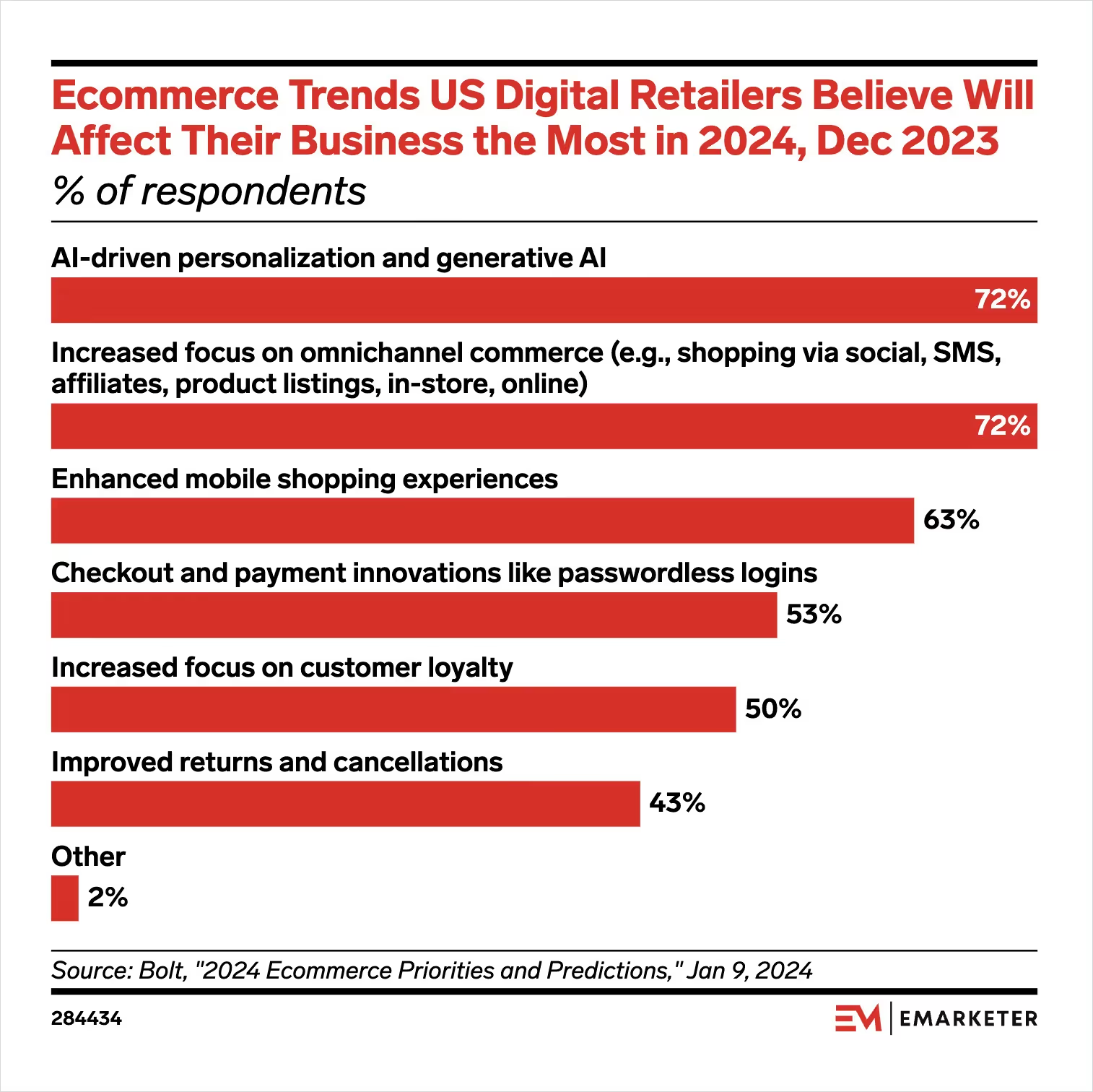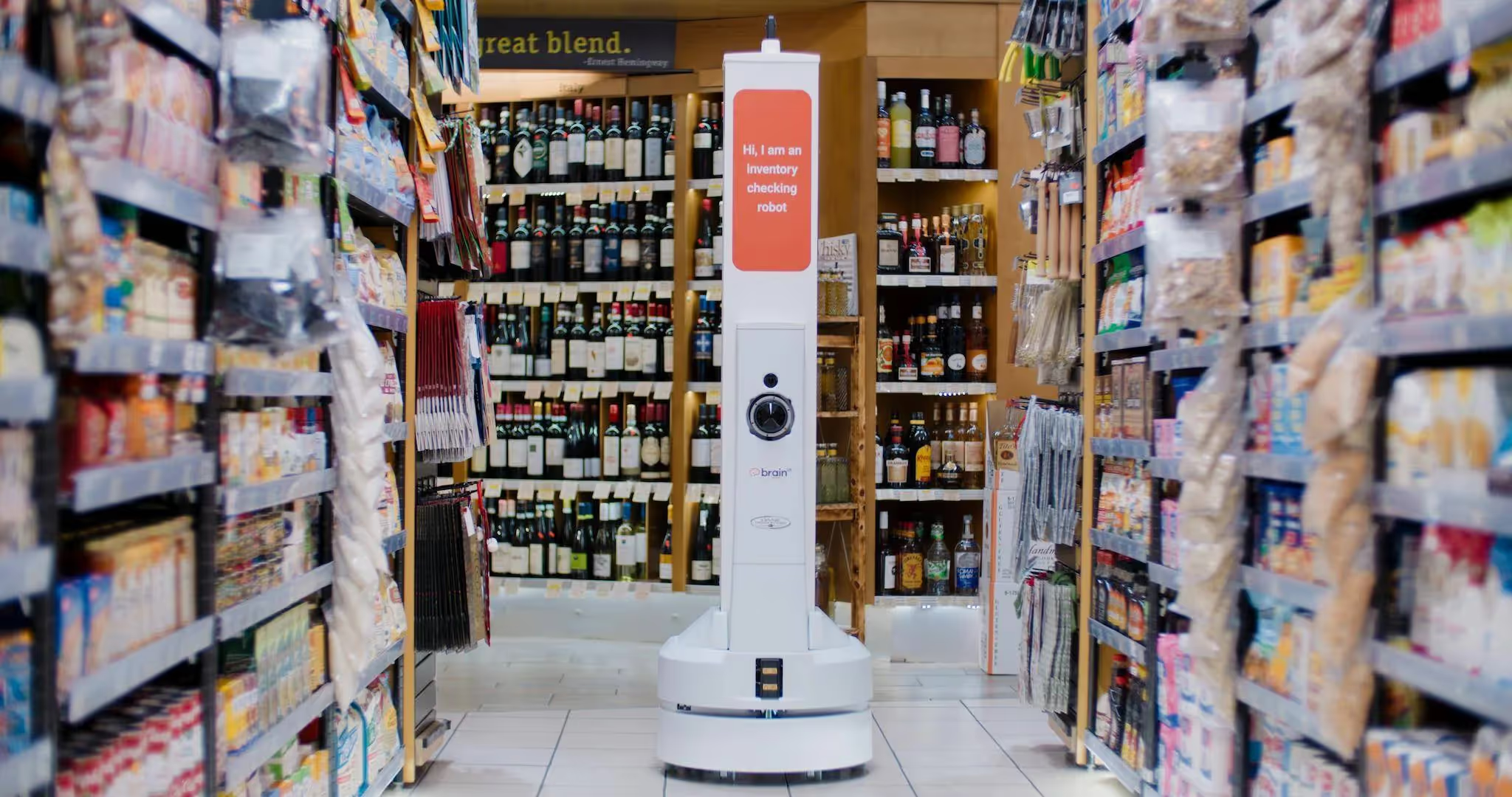Retail industry insights: trends to watch in 2024
Creating profitability in retail is more complex than ever. We bring together conversations and stats from multiple data sources so you can be part of retail’s next chapter.

Summary
Contents
The retail industry generates a staggering amount of information – innovative technologies, shifting consumer trends, operational strategies… there’s no end. Attempting to absorb it all can feel like drinking from a firehose.
To put it into perspective, since January 2024 (again, that’s 2024!), Google Scholar has indexed over 18,700 studies related to the retail industry. To stay on the cutting edge, you’d have to read about 75,000 studies… every year!
The view from the grapevine
Our robotics and AI customers are the individuals who make up the retail industry – the executives, decision-makers, and innovators who are shaping the future of retail every day. Through our daily interactions with these retail leaders, we’ve gained a perspective on the challenges and opportunities facing the industry.
So, what are the most relevant conversations happening in retail right now? What critical industry insights do tech buyers need to know in 2024? Let’s take a closer look.
1. AI-powered data analytics takes center stage
Artificial intelligence is revolutionizing how retailers handle the massive amounts of data at their disposal, transforming raw information into actionable business insights. AI is a game-changer, powering dynamic pricing, revenue and inventory optimization, and computer vision in brick-and-mortar stores to enhance the customer experience and gather valuable data.
However, implementing AI has its challenges. Retailers must navigate the complexity of integrating AI systems, ensure the accuracy and security of their data, and break down existing data silos to unlock the full potential of AI-driven analytics. Despite these hurdles, the vast majority of retailers plan to increase their AI investments in 2024. This comes as no surprise, given the ability of AI-powered solutions to drive operational efficiency. Almost 40% of retailers in 2023 said they used AI, machine learning, or computer vision, with another 15% planning to start within 12 months.
Brain Corp CTO Jarad Cannon recently told CNBC, “Retailers are spending a lot of money to know what’s coming into their stores through their inventory systems. They know quite a bit about what they’re selling, and that is leaving their stores. But in their stores on a daily basis, they don’t have a very good model of what’s happening on their shelves.” Autonomous inventory scanning robots and AI can help bridge these gaps, providing real-time data and insights to optimize operations.
As retailers continue to explore AI’s possibilities, it’s crucial to approach implementation strategically. This involves carefully evaluating your organization’s specific needs, identifying the most impactful use cases, and ensuring you have the necessary infrastructure and talent to support your AI initiatives. With a measured, data-driven approach, retailers can harness the power of AI to gain a competitive edge and deliver differentiating value to their customers.

2. Sustainability and ethical consumerism gain momentum
Environmental and social responsibility are becoming integral to retail operations across all sectors, from addressing food waste in grocery stores to promoting sustainable forestry in the furniture industry and ethical practices in the fashion world. This shift is driven by the growing demand from consumers for sustainable and ethically sourced products, with 64% of global consumers reporting having “very high” concerns about sustainability. This concern crosses the typical generational boundaries, with 68% of baby boomers and 72% of Gen Z customers very or extremely concerned.
But does customer spending also reflect their desire for better sustainability? The answer is a resounding yes. In recent years, sustainable offerings have experienced a remarkable 2.7x growth rate compared to their conventional counterparts.
As retailers navigate this landscape, they face questions such as:
- What strategies can I use to gather more accurate and timely data to enhance forecasting and predictability?
- How can technologies like blockchain enhance supply chain transparency?
- How can retailers effectively understand and address their customers’ concerns about ethical consumerism?
- What steps can retailers take to reduce their environmental footprint and promote circularity?
To meet the growing demand for sustainable and ethically sourced products, retailers must proactively embed environmental and social responsibility into their operations. This involves conducting thorough assessments of their supply chains, implementing traceability measures, and partnering with suppliers who share their commitment to sustainability.
Retailers should also prioritize transparent communication with customers about their sustainability initiatives and progress. By educating consumers about their efforts and engaging them in the journey towards a more sustainable future, retailers can foster deeper connections with their audience and differentiate themselves in an increasingly competitive market.
3. Omnichannel strategies become essential
The dawn of a cookie-free internet in January 2024 has forced retailers to rethink how they engage with customers across various touchpoints. With the loss of third-party cookies, retailers can no longer rely on tracking customer behavior across websites to deliver targeted advertising and personalized experiences. Instead, building relevance and maintaining meaningful connections with shoppers now requires a robust omnichannel approach that leverages first-party data and creates a seamless experience across all channels.
Retailers are grappling with a range of issues, from reinventing the in-store experience to leveraging social shopping, affiliate marketing, SMS campaigns, and loyalty programs. A major concern for retailers is striking the right balance between collecting data for personalization and respecting consumer privacy. Maintaining consistent messaging across all platforms while catering to individual preferences (such as the desire to opt out of certain holiday-related communications) is another critical challenge. However, only 45% of retailers feel prepared for the cookie-less landscape of 2024.
Against this fractured backdrop, retailers must develop a comprehensive, connective omnichannel strategy that seamlessly integrates online and offline experiences. This involves investing in technologies that enable accurate real-time data synchronization, inventory management, and personalized marketing across channels. By creating a unified, customer-centric approach, retailers can foster deeper relationships with their audience and drive long-term loyalty.
4. Best practices are still evolving, but hyper-personalization dominates
In a customer-centric retail ecosystem, personalization is king. Retailers are shifting away from broad demographic-based marketing in favor of highly targeted, individualized approaches. Leveraging natural language processing, generative AI, user-generated content, and social selling, brands aim to create unique experiences tailored to each shopper.
Unsurprisingly, the path to hyper-personalization is fraught with obstacles. Retailers must navigate the delicate balance between data privacy and the need for personalized experiences while ensuring the ethical use of customer data. While 80% of consumers expect personalized interactions, they are wary of surrendering their data and being treated as faceless group members rather than as individuals.
And consumers respond. AI-generated product recommendations are responsible for 35% of online retailer Amazon’s product recommendations.
To capitalize on the opportunities presented by hyper-personalization, retailers must invest in robust data management and analytics capabilities. This includes implementing secure data storage and processing systems and developing clear data governance policies that prioritize customer privacy and consent. Retailers must also build trust with their customers by being transparent about their data practices and demonstrating a commitment to responsible data use. By establishing a strong foundation of trust and investing in the necessary infrastructure, retailers can unlock the full potential of personalization while mitigating risks.

5. Economic uncertainty lingers from 2023 into 2024
Global growth projections for 2024 are slightly lower than the previous year, ranging from 2.5% to 3.5% (down from 3.6% in 2023). The anticipated inflation rate is disappointing for those who already watched inflation dominating retail conversations in 2023. Although slowing, persistent inflation continues to keep interest rates elevated and economic concerns at the forefront.
Meanwhile, the ongoing labor shortage affects all aspects of retail, from supply chain to logistics, driving up costs at a time when exceptional growth is needed to fund new investments.
Retailers are grappling with how to deliver the value-added benefits of AI, personalization, and omnichannel experiences in a world of tightening budgets. Scalability is crucial, which speaks to the continued focus on AI and robotics as retail solutions.
To navigate the challenges of economic uncertainty, retailers must focus on building resilience and adaptability in their operations. This involves implementing flexible supply chain strategies and investing in technologies that enable agile decision-making and resource allocation.
Retailers should also prioritize initiatives that drive operational efficiency and cost optimization, such as automation, process streamlining, and data-driven inventory management. By proactively addressing potential risks and building a strong foundation for growth, retailers can position themselves to thrive in the face of economic headwinds.

Navigating retail’s transformative journey
Retail executives and tech decision-makers are at the center of some of the industry’s most pivotal conversations. As AI, robotics, and other cutting-edge technologies become increasingly integrated into retail operations, these leaders will wield significant influence in shaping the future of retail in 2024 and beyond.
Embracing a technology-driven approach to tackle the challenges of the post-COVID retail landscape may feel like a revolutionary undertaking, but it is a necessary step forward. The conversations surrounding these transformative changes show no signs of slowing down; if anything, we anticipate they will only intensify throughout 2024.
At Brain Corp, our mission is to empower retail businesses with the tools and technologies they need to thrive in the face of emerging challenges. From leveraging robots with computer vision, RFID, and AI for inventory management to deploying autonomous robot scrubbers that enhance floor cleanliness, we are proud to be at the forefront of the most critical conversations in retail today.
Take the first step towards revolutionizing your retail operations – schedule a consultation with us for a personalized assessment of how autonomous AI solutions can transform your business.
Related product resources

Press release

Press release
Brain Corp Promotes John Black to Chief Technology Officer and Hires Dr. Kavitha Velusamy as Senior Vice President of Software and AI


